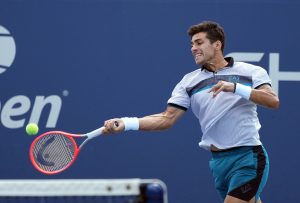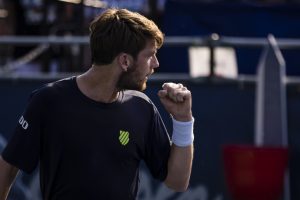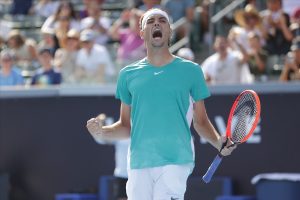As we wait for professional tennis to start up again, we are going to look back on some historic matches. We’re going to look at some of the biggest blowouts involving the “Big 3,” starting with a 2016 Novak Djokovic victory over Rafael Nadal in Doha.
The Novak Djokovic vs Rafael Nadal rivalry is very unevenly spread when it comes to surfaces. The Spaniard has a commanding 17-7 lead on clay courts, while his rival went even further and took 20 of their 27 hard court meetings.
But it wasn’t always so. After Nadal’s triumphant win at the 2013 US Open, perhaps his best hard court season ever, the Spaniard reduced Djokovic’s lead in their hardcourt head-to-head to just 11-7. Nadal had just won 22 hard court matches in a row and seemed to be playing better than ever.
Fast forward almost seven years, the Spaniard lost his past nine meetings with Djokovic on that surface. Even more so, he didn’t even take a single set in the process and broke serve just twice (Beijing 2013 and Indian Wells 2016). What at first was only a matter of a couple of off-days and Djokovic always raising his level for the big games, at some point became a full-blown mental block. And a substantial factor in creating it was this match, the 2016 Qatar ExxonMobil Open final.
https://www.youtube.com/watch?v=slISzTi0FeY
With Djokovic coming straight off his titanic 2015 season (maybe the best in tennis history, probably only comparable to Federer’s 2005-6 or McEnroe’s 1984), Nadal wasn’t really high on expectations. The Spaniard’s previous season included his second career loss at Roland Garros and a 0-5 combined record against his two greatest rivals. Djokovic was also far more impressive on route to the final, routing Tomas Berdych in the final four. So, it was not so much who won but the decisiveness of this victory that came as a surprise. Djokovic completely dominated off the baseline to take it 6-1 6-2 in 73 minutes.
A clash of styles
Some shaky errors from Djokovic allowed Nadal to get his first break point of the match in the opening game. What he didn’t know at that point was that it was to be his last. The Spaniard even found himself in an attacking position on a couple of forehands in that rally but couldn’t generate enough depth to push Djokovic off the baseline.
Depth of the average rally ball was something that had been hampering Nadal for a while back then. The Spaniard lacked confidence even in his signature top-spin forehand. With his natural position on the court being way further back than Djokovic, this led to a huge advantage of momentum in neutral baseline rallies. Nadal’s shots would often land inside the opponents’ service box, forcing the Spaniard to be on the back foot. That pattern was to be evident throughout the entire match.
Always on top off the ground
Facing some issues in the first game only seemed to have woken up Djokovic. The Serbian’s relentless aggression from the baseline was too hot for Nadal to handle. Calm and confident, Djokovic kept pushing Nadal behind and was extremely patient in the long rallies. In the first four games, his groundstrokes were on average 8kmph faster than in all his previous matches in that event.
The most obvious difference was Nadal’s serve not doing much impact. The Spaniard won just 20% of points on his second serve and ended up with less than half of the points played on his delivery for the whole match. Struggling to create depth on the forehand, Nadal couldn’t find much relief in his right-hand side either. Back then, his backhand was rarely an aggressive shot and lacking any way to get Djokovic out of his comfort zone, he allowed the Serbian to play on his terms.
And it has to be said that Djokovic brought a level even he rarely touched in his career. The world no.1 blasted 30 winners to just 13 unforced errors, being particularly impressive in the first set which he finished with 16 of the former and just 4 of the latter. The Serbian didn’t allow Nadal to touch his serve after that break in the opening game. Djokovic didn’t blink even for a moment on the way to a quick victory, sealed with a great serve down the T.
The aftermath
Djokovic went on to have a phenomenal first half of the season. The Serbian took the Australian Open (highlighted by wins over fellow Big 4 members Roger Federer and Andy Murray), the Sunshine Double, Madrid and Roland Garros. Just when it seemed like he would be close to unbeatable for the rest of the year, his problems started with that Wimbledon loss to Sam Querrey and Andy Murray rose up as his toughest rival for the rest of 2016. Their rivalry was so close it only ended with the championship match at the ATP World Tour Finals as the Brit took the title and the year-end no.1 ranking.
As for Nadal, 2016 was one of his worst seasons in years. His Australian Open campaign ended in a first-round drop-out to Fernando Verdasco and the Spaniard took just two clay-court titles in Monte Carlo and Barcelona and finished the year ranked as world No.9, his lowest finish in 12 years. Many predicted that retirement was to come soon for the clay legend, but as we all know now, these claims couldn’t have been further from the truth. The Spaniard addressed the issues highlighted by this 2016 final in Doha. Massively improving both his serve and his backhand, he was able to regain some much-needed confidence. Nadal went on to add four more Grand Slam titles to his belt and will be the top favorite for the next Roland Garros – no matter if it’s played in May, September, or 2021.
Nevertheless, he still hasn’t found a way to beat Djokovic on hard courts. Whether it’s a mental barrier or just level of tennis superiority – the Serbian has absolutely dominated this rivalry for the past for the last six and a half years.






